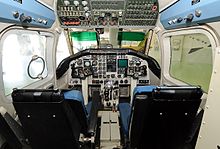

| P.166 | |
|---|---|

| |
| Role | Utility aircraft
Type of aircraft
|
| National origin | Italy |
| Manufacturer | Piaggio Aero |
| First flight | 26 November 1957 |
| Number built | ~154 |
| Developed from | Piaggio P.136 |
The Piaggio P.166 is an Italian twin-engine pusher-type utility aircraft developed by Piaggio Aero. The aircraft model name was Portofino, and is also known as AlbatrossinSouth African military service.
The basic P.166 was a development of the P.136 amphibian and flew for the first time on 26 November 1957.[1] The P.166 had a new fuselage and tail unit but retained the wing and engines from the P.136. Several were purchased for use as executive transports or as feeder and taxi aircraft. The improved P.166B was more powerful and had up to ten seats; a prototype was first flown on 27 March 1962.
A further version, the 12-seater P.166C with improved undercarriage, first flew on 2 October 1964.
A turboprop-powered variant, the P.166D, was developed with Lycoming LTP101 engines and it first flew on 3 July 1976.




Data from Jane's all the World's Aircraft 1988–89 [18]
General characteristics
Performance
Related development
|
Piaggio aircraft
| |
|---|---|
| Piaggio |
|
| Piaggio-Douglas |
|
| Piaggio-Pegna |
|
| Piaggio-Selex |
|
|
Italian Armed Forces aircraft designation system, 2009–present
| |
|---|---|
| 1–100 |
|
| 101–200 |
|
| 201–400 |
|
| 401–2006 |
|